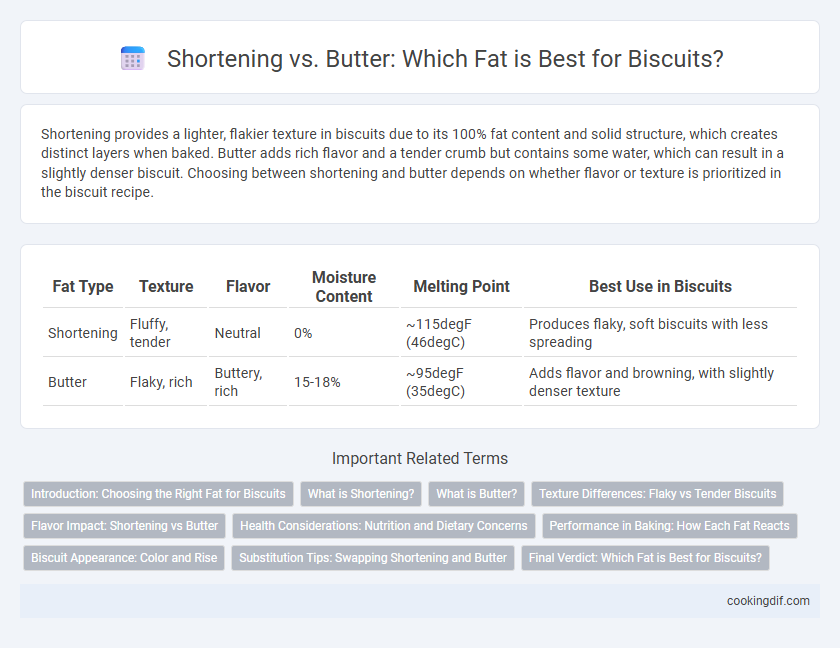Shortening provides a lighter, flakier texture in biscuits due to its 100% fat content and solid structure, which creates distinct layers when baked. Butter adds rich flavor and a tender crumb but contains some water, which can result in a slightly denser biscuit. Choosing between shortening and butter depends on whether flavor or texture is prioritized in the biscuit recipe.
Table of Comparison
| Fat Type | Texture | Flavor | Moisture Content | Melting Point | Best Use in Biscuits |
|---|---|---|---|---|---|
| Shortening | Fluffy, tender | Neutral | 0% | ~115degF (46degC) | Produces flaky, soft biscuits with less spreading |
| Butter | Flaky, rich | Buttery, rich | 15-18% | ~95degF (35degC) | Adds flavor and browning, with slightly denser texture |
Introduction: Choosing the Right Fat for Biscuits
Shortening provides biscuits with a tender, flaky texture due to its higher melting point and 100% fat content, making it ideal for achieving lift and softness. Butter offers rich flavor and a slightly denser crumb, enhancing the overall taste with natural milk solids and water content. Selecting between shortening and butter depends on whether the priority is texture or flavor in biscuit preparation.
What is Shortening?
Shortening is a solid fat made from vegetable oils that is hydrogenated to achieve a crumbly texture ideal for baking biscuits. Unlike butter, shortening has a higher melting point, which helps create flakier layers and a lighter crumb. Its neutral flavor and longer shelf life make it a versatile fat choice in biscuit recipes.
What is Butter?
Butter is a dairy product made by churning cream, containing about 80% fat, primarily saturated fat with natural milk solids and water. It provides rich flavor and contributes to tender, flaky biscuit texture through its melting properties. Compared to shortening, butter offers superior taste and browning but has a lower melting point, affecting biscuit rise and crumb structure.
Texture Differences: Flaky vs Tender Biscuits
Shortening creates a higher melting point fat layer in biscuit dough, producing distinct flakes and a flaky texture ideal for layered biscuits. Butter's lower melting point and water content lead to a softer, more tender crumb with rich flavor but less pronounced layers. Choosing shortening yields flakier biscuits, while butter results in delicate, tender biscuits with a buttery taste.
Flavor Impact: Shortening vs Butter
Butter imparts a rich, creamy flavor to biscuits due to its milk solids and natural sweetness, enhancing the overall taste profile. Shortening provides a neutral flavor that allows other ingredients to stand out but lacks the depth and complexity butter offers. Using butter often results in a more flavorful biscuit with a golden color and aromatic appeal, while shortening yields a lighter, flakier texture but less pronounced buttery taste.
Health Considerations: Nutrition and Dietary Concerns
Shortening provides a higher amount of trans fats, which may increase the risk of heart disease compared to butter's natural saturated fats and fat-soluble vitamins like A and D. Butter contains beneficial nutrients but also higher cholesterol levels, posing concerns for individuals with cardiovascular conditions. Choosing between shortening and butter depends on balancing the risks of trans fats versus saturated fats, considering individual dietary needs and health goals.
Performance in Baking: How Each Fat Reacts
Shortening provides a higher melting point, resulting in flakier, lighter biscuits due to slower fat melting during baking, which traps air more effectively. Butter contributes richer flavor and browning from milk solids but melts faster, leading to slightly denser biscuits. Performance in baking depends on balancing texture preference and flavor intensity when choosing between shortening and butter for biscuit fat.
Biscuit Appearance: Color and Rise
Choosing shortening over butter in biscuit recipes enhances rise and creates a taller, fluffier texture due to shortening's higher melting point and solid state at room temperature. Butter contributes a richer flavor and promotes a golden-brown color thanks to milk solids caramelizing during baking. For optimal biscuit appearance, combining both fats can balance an appealing rise with a desirable golden hue.
Substitution Tips: Swapping Shortening and Butter
Swapping shortening and butter in biscuit recipes requires adjusting for moisture and flavor differences, as butter contains about 15-20% water, making dough slightly wetter and richer than shortening. Use a 1:1 ratio when substituting, but chill the dough thoroughly when using butter to prevent spreading due to its lower melting point compared to shortening. For a flakier texture, cut the fat into the flour while it's cold, regardless of whether you choose butter or shortening, and adjust baking time slightly to account for variations in fat content.
Final Verdict: Which Fat is Best for Biscuits?
Butter provides superior flavor and a tender crumb due to its water content creating steam during baking, which helps achieve flaky layers in biscuits. Shortening yields a lighter, fluffier texture with higher melting points that prevent biscuits from spreading too much, ideal for soft, pillowy results. For the best balance of taste and texture, many bakers prefer using a combination of butter and shortening to enhance both flavor and flakiness in biscuits.
Shortening vs Butter for fat choice Infographic

 cookingdif.com
cookingdif.com